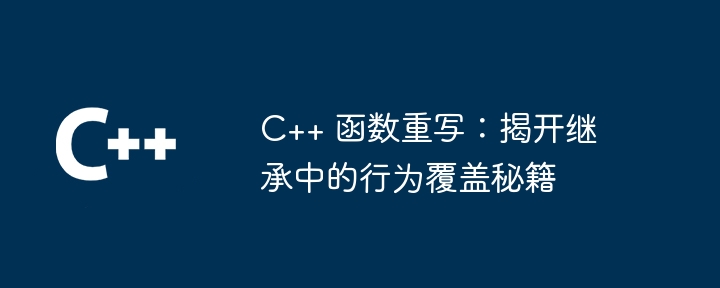C++ 函数重写:揭开继承中的行为覆盖秘籍
当派生类定义同名且实现不同的函数时,发生函数重写。规则包括:使用 override 关键字。名称、参数和返回类型与基类函数相同。访问权限不得低于基类函数。通过重写,派生类可以覆盖基类行为,实现多态,动态调用不同派生类的同名方法。

C 函数重写:揭开继承中的行为覆盖秘籍
在 C 中,函数重写是一种通过继承实现多态行为的关键特性。当派生类定义一个与其基类同名且具有不同实现的函数时,就会发生函数重写。
语法和规则
为了重写基类函数,派生类必须使用 override 关键字。例如:
class Base {
public:
virtual void print() {
cout << "Base class print()" << endl;
}
};
class Derived : public Base {
public:
virtual void print() override {
cout << "Derived class print()" << endl;
}
};函数重写的规则如下:
- 派生类函数必须具有相同名称、参数列表和返回类型。
- 派生类函数必须使用
override关键字。 - 派生类函数的访问权限不得低于基类函数。
实战案例
考虑一个形状抽象类和它的两个派生类矩形和圆。
class Shape {
public:
virtual double getArea() = 0;
};
class Rectangle : public Shape {
public:
double width, height;
Rectangle(double w, double h) : width(w), height(h) {}
override double getArea() {
return width * height;
}
};
class Circle : public Shape {
public:
double radius;
Circle(double r) : radius(r) {}
override double getArea() {
return M_PI * radius * radius;
}
};
int main() {
Rectangle rect(5, 3);
Circle circle(4);
Shape* shapes[] = {&rect, &circle};
for (auto shape : shapes) {
cout << "Shape area: " << shape->getArea() << endl;
}
}在这个示例中,Shape 类定义了一个抽象方法 getArea(),由派生类 Rectangle 和 Circle 重写以提供实际的面积计算。通过多态,我们可以使用 shapes 数组中的基类指针调用 getArea() 方法,从而动态地计算和输出不同形状的面积。
以上是C++ 函数重写:揭开继承中的行为覆盖秘籍的详细内容。更多信息请关注PHP中文网其他相关文章!

热AI工具

Undresser.AI Undress
人工智能驱动的应用程序,用于创建逼真的裸体照片

AI Clothes Remover
用于从照片中去除衣服的在线人工智能工具。

Undress AI Tool
免费脱衣服图片

Clothoff.io
AI脱衣机

AI Hentai Generator
免费生成ai无尽的。

热门文章

热工具

记事本++7.3.1
好用且免费的代码编辑器

SublimeText3汉化版
中文版,非常好用

禅工作室 13.0.1
功能强大的PHP集成开发环境

Dreamweaver CS6
视觉化网页开发工具

SublimeText3 Mac版
神级代码编辑软件(SublimeText3)

热门话题
 如何在C++中实现策略设计模式?
Jun 06, 2024 pm 04:16 PM
如何在C++中实现策略设计模式?
Jun 06, 2024 pm 04:16 PM
策略模式在C++中的实现步骤如下:定义策略接口,声明需要执行的方法。创建具体策略类,分别实现该接口并提供不同的算法。使用上下文类持有具体策略类的引用,并通过它执行操作。
 如何在C++中实现嵌套异常处理?
Jun 05, 2024 pm 09:15 PM
如何在C++中实现嵌套异常处理?
Jun 05, 2024 pm 09:15 PM
嵌套异常处理在C++中通过嵌套的try-catch块实现,允许在异常处理程序中引发新异常。嵌套的try-catch步骤如下:1.外部try-catch块处理所有异常,包括内部异常处理程序抛出的异常。2.内部try-catch块处理特定类型的异常,如果发生超出范围的异常,则将控制权交给外部异常处理程序。
 如何使用C++模板继承?
Jun 06, 2024 am 10:33 AM
如何使用C++模板继承?
Jun 06, 2024 am 10:33 AM
C++模板继承允许模板派生类重用基类模板的代码和功能,适用于创建具有相同核心逻辑但不同特定行为的类。模板继承语法为:templateclassDerived:publicBase{}。实例:templateclassBase{};templateclassDerived:publicBase{};。实战案例:创建了派生类Derived,继承了基类Base的计数功能,并增加了printCount方法来打印当前计数。
 char在C语言字符串中的作用是什么
Apr 03, 2025 pm 03:15 PM
char在C语言字符串中的作用是什么
Apr 03, 2025 pm 03:15 PM
在 C 语言中,char 类型在字符串中用于:1. 存储单个字符;2. 使用数组表示字符串并以 null 终止符结束;3. 通过字符串操作函数进行操作;4. 从键盘读取或输出字符串。
 在Docker环境中使用PECL安装扩展时为什么会报错?如何解决?
Apr 01, 2025 pm 03:06 PM
在Docker环境中使用PECL安装扩展时为什么会报错?如何解决?
Apr 01, 2025 pm 03:06 PM
在Docker环境中使用PECL安装扩展时报错的原因及解决方法在使用Docker环境时,我们常常会遇到一些令人头疼的问�...
 c上标3下标5怎么算 c上标3下标5算法教程
Apr 03, 2025 pm 10:33 PM
c上标3下标5怎么算 c上标3下标5算法教程
Apr 03, 2025 pm 10:33 PM
C35 的计算本质上是组合数学,代表从 5 个元素中选择 3 个的组合数,其计算公式为 C53 = 5! / (3! * 2!),可通过循环避免直接计算阶乘以提高效率和避免溢出。另外,理解组合的本质和掌握高效的计算方法对于解决概率统计、密码学、算法设计等领域的许多问题至关重要。
 c语言多线程的四种实现方式
Apr 03, 2025 pm 03:00 PM
c语言多线程的四种实现方式
Apr 03, 2025 pm 03:00 PM
语言多线程可以大大提升程序效率,C 语言中多线程的实现方式主要有四种:创建独立进程:创建多个独立运行的进程,每个进程拥有自己的内存空间。伪多线程:在一个进程中创建多个执行流,这些执行流共享同一内存空间,并交替执行。多线程库:使用pthreads等多线程库创建和管理线程,提供了丰富的线程操作函数。协程:一种轻量级的多线程实现,将任务划分成小的子任务,轮流执行。
 如何处理跨线程的C++异常?
Jun 06, 2024 am 10:44 AM
如何处理跨线程的C++异常?
Jun 06, 2024 am 10:44 AM
在多线程C++中,异常处理通过std::promise和std::future机制实现:在抛出异常的线程中使用promise对象记录异常。在接收异常的线程中使用future对象检查异常。实战案例展示了如何使用promise和future在不同线程中捕获和处理异常。






